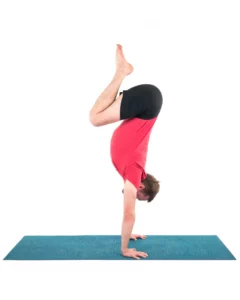Transitioning: The Essential Skill for Healthy Aging

I’ve been thinking about whether there is one essential skill that is of utmost importance to maintaining healthy aging. This has been prompted to some extent as I observe the challenges my own mother has following two hip fractures in the last 10 years and a general decline in overall activity. Of course, my suggestion will apply to some people, but not to others, as we all face various challenges and issues with advancing age.
All that said, I return again and again to the importance of the ability to “transition” with coordinated ease as my number one essential skill for healthy aging. What do I mean by transitions? It is the ability to rise from sitting on the floor, bed, toilet, or chair to standing and from standing back down.
On a recent yoga retreat, I observed the challenge that arises for those with foot injuries or the effects of a sedentary lifestyle, and even one student in their 80s post knee replacements. Poor transition ability limits your activity potential, makes everyday moments more challenging, such as getting out of bed in the morning, and it increases the chances of falls and injuries when attempting to get up and down. Transitioning is, in my estimation, essential for activities of daily living, let alone those activities that you also may want to do, like getting down to weed the garden or to the floor to play with pets or children!
Transitioning Ability: A Key to Healthy Aging
Past research has demonstrated that good transitioning ability is an independent predictor of longevity, and poor transitioning ability is an independent predictor of mortality (yep, death!). You can read an abstract about it here: Ability to sit and rise from the floor as a predictor of all-cause mortality.
Good transitioning involves many different abilities: adequate body strength, especially the lower body; flexibility of the major joints of the body, including ankles, knees, hips, and spine; balance and agility as one moves from one position to the next; proprioception, or awareness of where your body is in space and where body parts are moving relative to one another; cognitive health so that the constant communication between brain and body and body and brain flows efficiently and smoothly.
How to Improve Transitioning Ability with Yoga
 How do you maintain or improve your transition ability? Here’s what I recommend:
How do you maintain or improve your transition ability? Here’s what I recommend:
1. A well-balanced yoga practice done regularly: this will address overall strength, flexibility, balance, and agility, as well as improve proprioception and brain health.
2. Add light ankle and hand weights into some of your yoga poses and use resistance bands to increase overall strength when doing your yoga poses.
3. Targeted strengthening of the lower body with yoga poses such as:
- Powerful Pose (Utkatasana)
- Garland Pose (Malasana): deep squat
Balancing poses on one leg, such as:

- Tree Pose (Vrksasana)
- Or even better, Eagle Pose (Garudasana): Keep those knees bent!
- Healthy forward bending actions such as my Intelligent Forward Fold (also called Fig Leaf Forward Fold)
4. Specific dynamic transitioning practices, such as the videos below.
Those are my suggestions, and knowing our audience, I will be hearing back from many of you on your tested methods for maintaining and improving transitioning ability. I always look forward to feedback, which is another opportunity to learn something new!
Transitions in Yoga Practice
1. Kneeling Transition
2. Easy Sitting Pose Transition
3. Transitioning via Fig Leaf Forward Fold
Also, read...
Warrior I Pose: 5 Strengthening Variations
Deepening Your Home Yoga Practice: An Interview with Judith Hanson Lasater
4 Easy Ways to Use a Sandbag in Yoga Practice
Related courses
Breath as Medicine: Yogic Breathing for Vital Aging
Yoga and Myofascial Release: Releasing Chronic Tension with the Bodymind Ballwork Method

Baxter Bell, MD, C-IAYT, YACEP, fell in love with yoga in 1993 while he was working full-time as a family physician. His appreciation for the potential of yoga to foster health, healing, and equanimity was so great that he soon stepped down from his medical practice and trained to become a yoga teacher. Now, he focuses on teaching yoga full time, both to ordinary students of all ages and physical conditions and to the next generation of yoga teachers and yoga therapists, to whom he teaches anatomy and yoga therapy along with his accessible, skillful style of yoga. He also sees students privately, helping them use yoga to help heal from and/or cope with a wide range of medical conditions. At this point, with 23+ years of teaching experience under his belt, Baxter brings a unique perspective to his teaching, combining his understanding of anatomy and medicine with his skill at instructing people from all walks of life and all levels of ability.
In addition to teaching classes, workshops, and retreats internationally, Baxter is a past presenter at Yoga Journal Conferences and the International Association of Yoga Therapy’s Sytar Conference and teaches online courses and classes at Yoga U Online. Baxter is also the co-author of the popular and ground-breaking book Yoga for Healthy Aging and his blog, “What’s On Your (Yoga) Mind,” where he shares his knowledge of medical conditions, anatomy, yoga, and more with practitioners and teachers across the world. He has written articles for the Yoga Journal and the Journal of the International Association of Yoga Therapy. He is often quoted as an expert on yoga and health by major national news outlets such as the Washington Post and the Wall Street Journal. To learn more, visit www.baxterbell.com, and his YouTube channel and Instagram page at Baxter Bell Yoga.



